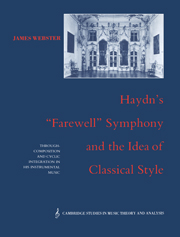 Haydn's 'Farewell' Symphony and the Idea of Classical Style
Haydn's 'Farewell' Symphony and the Idea of Classical Style Summary
THE ORIGINS OF THE FAREWELL SYMPHONY
Every music-lover knows the story of Haydn's “Farewell” Symphony. Each year, the Esterhazy court spent the warm season at Prince Nicolaus's new and splendid, but remote, summer castle “Eszterhaza.” With the exception of Haydn and a few other privileged individuals, the musicians were required to leave their families behind in Eisenstadt. (This much is independently documented.) Haydn's biographer Griesinger continues:
One year, against his usual custom, the prince determined to extend his stay in Eszterhaza for several weeks. The ardent married men, thrown into utter consternation, turned to Haydn and asked him to help. Haydn hit upon the idea of writing a symphony in which, one after the other, the instruments fall silent. At the first opportunity, this symphony was performed in the prince's presence. Each of the musicians was instructed that, as soon as his part had come to an end, he should extinguish his light, pack up his music, and leave with his instrument under his arm. The prince and the audience at once understood the point of this pantomime; the next day came the order for the departure from Eszterhaza. Thus Haydn related the occasion for the Farewell Symphony to me; the other version, that Haydn thereby dissuaded his prince from his intention to dissolve the entire Kapelle, … is to be sure more poetic, but not historically correct.
- Type
- Chapter
- Information
- Haydn's 'Farewell' Symphony and the Idea of Classical StyleThrough-Composition and Cyclic Integration in his Instrumental Music, pp. 1 - 10Publisher: Cambridge University PressPrint publication year: 1991
